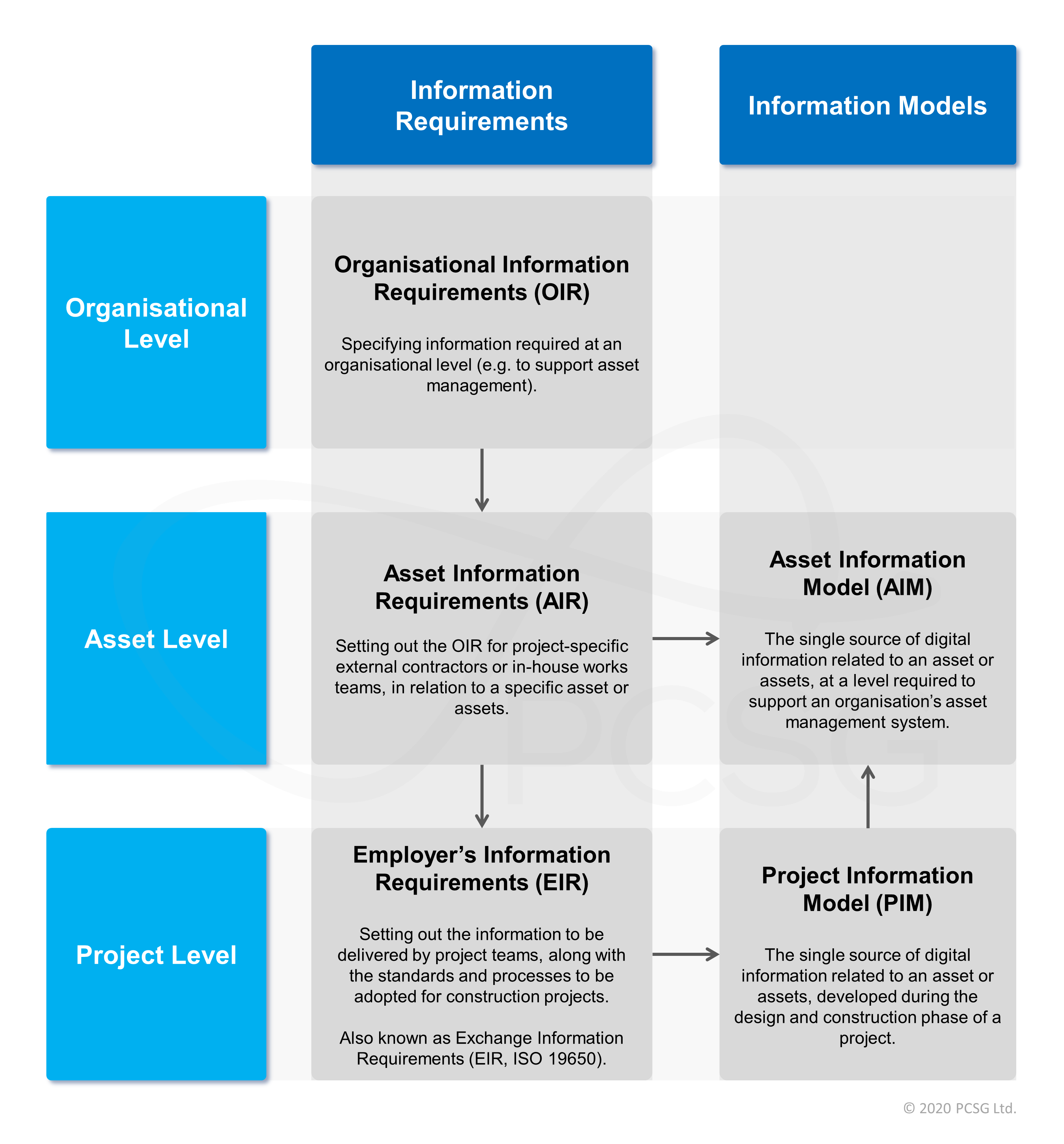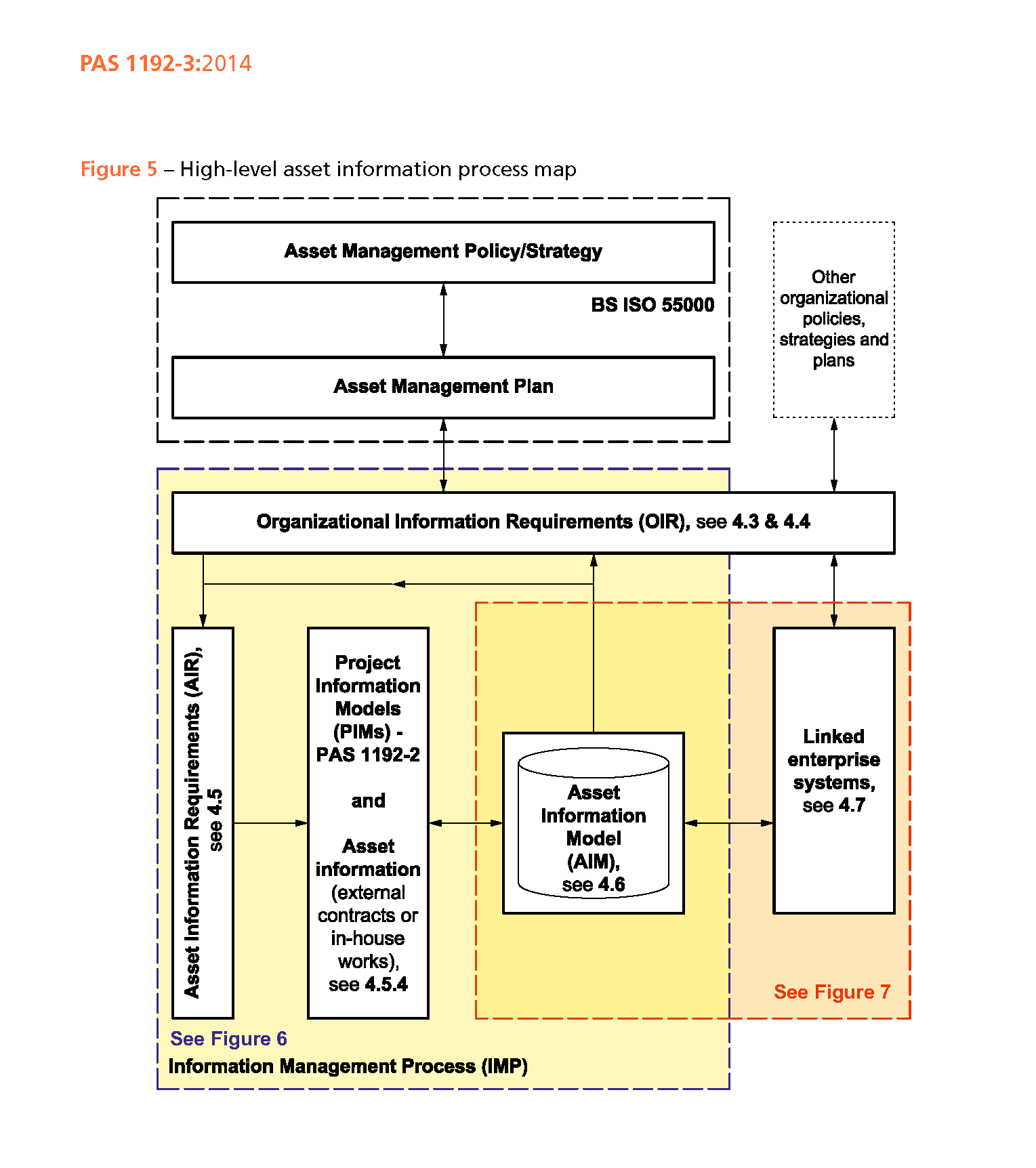Asset information requirements AIR
Contents |
[edit] Introduction
Asset Information Requirements (AIR) define the information required to operate and maintain a built asset in line with an organisation’s asset management strategy.
[edit] Definition
Asset Information Requirements (AIR) are part of the Building Information Modelling (BIM) process, defining the graphical and non-graphical data, information and documentation needed for the lifetime operation and management of a built asset.
ISO 19650 defines AIR as 'information requirements in relation to the operation of an asset'; an information requirement is defined as 'specification for what, when, how and for whom information is to be produced'.
PAS 1192 defines AIR as 'data and information requirements of the organisation in relation to the asset(s) it is responsible for' (PAS 1192-3).
The UK BIM framework provides some resources to support implementation, these include:
[edit] Resources
The UK BIM framework provides some resources to support implementation, these include:
In addition, we are keen to include any resources which support implementation of the UK BIM Framework. Please do let us know if you have used, or created, a resource you believe others would benefit from.
[edit] Description
The efficient delivery and operation of a built asset relies partly on the operators’ ability to make sure the right people have access to the right information, in the right format and at the right time in order to make well-informed decisions and to effectively operate the asset.
In the BIM process, these information needs are called asset information requirements: the information required to operate and maintain a built asset throughout its lifecycle. The information will be about the real-world built asset (i.e. what was actually built, not what was planned).
The asset information requirements will be formally and explicitly defined in a document called the Asset Information Requirements (AIR). This document will define the requirements for the provision and management of information about a built asset in line with the organisation’s wider asset management plan, as defined in the Organisational Information Requirements (OIR).
Asset information requirements, once defined, will help enable the creation of an Asset Information Model (AIM). The data and information collated in response to the AIR comprises the AIM, which will therefore contain all the information required by the asset management plan in the required format for the lifetime operation and maintenance of the asset.
The responsibility to provide data and information to respond to the AIR is likely to be distributed across both the asset owner and/or operator and their supply chain.
The AIR should cover the entire asset lifecycle. As such, the AIR informs the development of the Exchange Information Requirements (EIR (ISO 19650)), or Employer’s Information Requirements (EIR (BS/PAS 1192)), for a capital project.
Trigger events (defined in PAS 1192-3:2014 as a “planned or unplanned event that changes an asset or its status”) often necessitate the assessment of the AIR and when the AIM needs to be updated.
PAS 1192-3 gives further information on how AIR should be used:
“…AIR shall be specified as part of a contract or as an instruction to in-house teams and may use data and information from the AIM relating to the asset management activities being carried out. The AIR shall also specify data and information to be captured and fed into the AIM. Where the activities relate to major works covered by PAS 1192-2, then the AIR will inform the EIR.”
This paragraph instructs that AIR:
- Should be specific to an asset;
- Should be included as part of a contract or delivered as an instruction to in-house teams;
- Will inform the information requirements defined in the EIR, where the asset activities relate to major works covered by PAS 1192-2;
- Will specify data and information that will be captured and added to the AIM; and
- May include information about the asset management activities and strategies being carried out using the AIM.
[edit] Development
The AIR should define what information will be required to operate and maintain the asset throughout its lifecycle. These information requirements can be extremely broad and comprehensive. They will inform the contents of both the AIM and the EIR document.
When first writing an AIR, PAS 1192-3 suggests that “the AIR may start as descriptive text”, outlining or summarising the scope of the asset information requirements to be defined.
However, the final document should be very precise and exact. PAS 1192-3 continues on to say that the AIR “should then be developed into a digital plan of deliverables.” This means that the AIR should not only define what information is required, but also how that information should be delivered in order to be used in the operation and maintenance of the asset.
Creating an AIR is a task of considerable scale, and PAS 1192-3 warns that “the effort to complete this should not be underestimated.”
[edit] Contents
According to ISO 19650, AIR set out three aspects of asset information:
- Managerial: Defines the information standards and production methods and procedures to be used by the delivery team.
- Commercial: Defines the information standards and production methods and procedures to be used by the delivery team.
- Technical: Details the information specifications to meet the organisational information requirements relevant to the asset.
The following are examples of possible asset information requirements from PAS 1192-3, based on guidance in PAS 55-2:2008 and BS 8587:2012:
| Type of Information | Examples of Information |
| Managerial |
|
| Commercial |
|
| Technical |
|
| Financial |
|
| Legal |
ISO 19650 also states that trigger events during asset operation should prompt a new set of AIR, and that AIR should refer to security requirements where appropriate.
In defining the AIR, the asset owner and/or operator needs to specify the information-sharing protocols and the information and systems to be deployed. On a capital project, these protocols are prescribed in the EIR. During the operation and maintenance of assets, these protocols should be documented in the Asset Management Plans.
[edit] Standards
The key standards regarding the creation and use of Asset Information Requirements (AIR) are:
- ISO 19560-1:2018 Organization and digitization of information about buildings and civil engineering works, including Building Information Modelling (BIM) -- Information management using Building Information Modelling -- Part 1: Concepts and Principles
- PAS 1192-3:2014 Specification for information management for the operational phase of assets using building information modelling
- ISO 55000:2014 Asset management – Overview, principles and terminology
- BS 8536-1:2015 Code of practice for facilities management (Buildings infrastructure)
- BS 8536-2:2016 Design and construction: Code of practice for asset management (Linear and geographical infrastructure)
[edit] Relationships to other parts of the BIM process
The diagram below shows how the AIR is related to other key parts of the BIM process:
[edit] AIR and Organisational Information Requirements (OIR)
An asset management strategy should be defined at an organisational level, rather than on an asset-by-asset basis. Asset Information Requirements (AIR) should therefore be developed from organisational information requirements. As with asset information requirements, organisational information requirements are defined in a document entitled Organisational Information Requirements (OIR).
An OIR will describe the information required by an organisation’s asset management systems and other organisational functions. OIRs are therefore not specific to any one project or asset.
According to ISO 19650, the OIR provides the input to the AIR (i.e. is the only source of input to the AIR).
[edit] AIR and Asset Information Model (AIM)
The information required to create an Asset Information Model (AIM) is defined in the Asset Information Requirements (AIR).
According to ISO 19650, the AIR determines the content, structure and methodology of the AIM.
The information added to an AIM can come from different sources: existing asset information systems, new information (e.g. if upgrades are made to the existing asset), or information in a Project Information Model (PIM) that was created for the construction of a new asset or the modification of an existing asset.
In the case of a new asset, the AIR will have been used to develop the Exchange/Employer’s Information Requirements (EIR). These will have been incorporated into the tender documentation for the project and used to define the delivery of the asset information.
[edit] AIR and Exchange/Employer’s Information Requirements (EIR)
The Exchange Information Requirements (EIR (ISO 19650)), or Employer’s Information Requirements (EIR (BS/PAS 1192)), is the document used to communicate the organisational and asset information requirements (OIR & AIR) to the contractor(s) and subcontractor(s) employed on a project.
Therefore, asset information requirements identified by the OIR and defined in the AIR will be used to create the EIR.
According to ISO 19650, the AIR provides an input to the EIR (i.e. it is not the only input).
[edit] AIR and Asset Management Strategy
The diagram below shows the relationship between the AIR, OIR, and AIM in the wider context of an organisation’s asset management plan. (Extract from Figure 5 of PAS 1192-3.)
--Cohesive
[edit] Related articles
- Asset information model.
- BIM.
- COBie.
- Creating an asset register for construction projects.
- Employer’s Information Requirements.
- Information management process.
- Information requirements.
- Organisational Information Requirements.
- PAS 1192-3.
- Project information model.
[edit] External resources
- ISO 19650-1
- ISO 55000
- BS 8536 parts 1 and 2
- UK Government BIM Working Group, CDE Sub Group: Asset Information Management - Common Data Environment (Functional Requirements) (https://www.cdbb.cam.ac.uk/news/2018AugCDE)
BIM Directory
[edit] Building Information Modelling (BIM)
[edit] Information Requirements
Employer's Information Requirements (EIR)
Organisational Information Requirements (OIR)
Asset Information Requirements (AIR)
[edit] Information Models
Project Information Model (PIM)
[edit] Collaborative Practices
Industry Foundation Classes (IFC)









